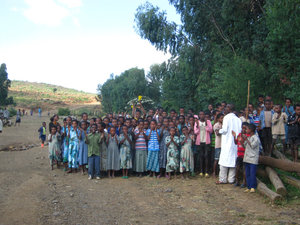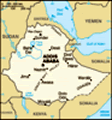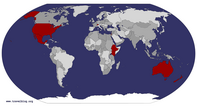Advertisement
Published: November 17th 2013

 Welcoming committee!
Welcoming committee!
How's this to welcome in your day?Today is our first service day and we’ve self-elected into three different groups: 1) deworming & children’s games, 2) building school, and 3) painting mural on school building. Again, this is my first time to ever involve myself in international humanitarian endeavors. While I am highly skeptical of any lasting impact of our brief time here (I liken it to a back-rub versus long-term medical care), I do think these service days might be worthwhile in that they give us, the participants, time to interact with JDC projects and Ethiopian people in a way far different than snapping photos or staged conversations. And yes, I do feel these days are more for our group than the Ethiopians. But that doesn’t negate the positives of service, just tempers them.
Groups 1 and 2 (I’m part of Group 1) are headed to the same school in Ategaye. The drive takes us well out of Gondar and through ag field after ag field, the smooth crops rising and falling gently with the swell of hills. The drive takes us through a couple of small villages before we finally reach our destination. Ategaye looks like any other village but

 School houses at Ategaye
School houses at Ategaye
New school house off to the leftfor the school house snugged in closely amidst eucalyptus trees, fields, and rounded wooden huts with peaked roofs. As our jeeps pull in, we see with delight that we have a welcoming committee. The children have been assembled in a dense group and as soon as we pile out, they start chanting “welcome! Welcome! Welcome!” clapping their hands in time. We meet our welcome with grins and photos and we clap along too. The welcoming committee goes on for several minutes until finally the teachers break them up and shoo them, gradually, to the school house.
The children are in first through third grade and range in age from 5 to 13 or so. The school room that exists here has three rooms, grey cement blocks with barely enough desk space inside. No decorations or bright learning aids adorn these rooms. There’s one chalkboard each and that’s it. On one end is a wooden room that’s been tacked on to fit the overflow of children. The school we’re helping build (funded by the JDC) is right close and already the work crew has laid the foundation and is starting to build the walls, brick-by-brick. I learn from the foreman,

 Deworming station
Deworming station
Photo credit to MishaDanny, that each classroom holds 60 children and so this small schoolhouse will enable 120 more children to learn behind desks. I’m reminded of how the accounting students back in Addis Ababa told us that one of the major stumbling blocks for rural education is lack of schoolhouses. Buildings matter. Desks matter. Without them, teachers will gamely carry on outdoors, but attention and retention are low in those situations.
Tables are set outside for the deworming and I sit down and (after instruction) start popping out the pills into cups . We set up an assembly line with cups of water, pills, and markers so that we can administer the pills and make sure to mark all the children who’ve successfully taken their meds. I have little time to interact with the children, shy but obedient, as they are herded by teachers toward us but I see their rough-and-tumble clothes, the fact that many girls have their heads shaved (to ward off lice?), the warts on some of their faces (which our medical group members told us was a sign of being HIV-positive), the grey scaly patches spreading across some cheeks (which is
a fungal infection). But at least there are no distended bellies, a sign of starvation. And only a minority of the children have obvious signs of serious diseases or infection. Mostly they are regular adorable kids, watching us avidly and ducking their heads when we look back.
After the deworming, my group splits into pairs into the classrooms. They’ve brainstormed very simple action-and-word games like “heads, shoulders, knees and toes.” I walk around to take photos with the JDC camera. I’d intended to help with deworming all day as we’d originally been told that that would indeed take all day and the games would simultaneously occur. But, not surprisingly, plans changed as soon as we arrived. And here I am in a skirt and wedge-heeled sandals. Not smart. Rookie mistake not to plan for any occasion! But I don’t stop traversing between the classrooms and the building site, snapping away on the iPhone. Tiny pods of girl-children follow me, hanging back until I motion them toward me to show them photos. I have no idea why they are not in class or if they’re supposed to be at all, but no teacher scolds them.
The group helping with

 Building the school house!
Building the school house!
Photo credit to one of my group members (can't remember who right now...)building is tasked with hauling cinder blocks or mooshing cement in-between laid blocks on the walls. The regular work crew is both men and women, but the jobs are strictly divided gender-wise. The men haul blocks, mix cement, and lay bricks. The women haul water (for the cement) and slop the mixed cement from the middle of the site to the feet of the cement-layers. The foreigners are allowed more lee-way. The cement is made from water, sand, and dry cement powder. The cinderblocks are not much different and if dropped will easily crack. Eden comments that these schoolhouses are built of sand and that’s a pretty accurate summation. However simple, they’re solid though.
After I take 
 Traditional coffee ceremony
Traditional coffee ceremony
One of the teachers insisted on changing into her traditional dress so our pictures would look right!pictures for a while, I jump in to the building site as I’m starting to feel useless. But I’m really not dressed for this and walk out of my shoes several times while trying to be useful. Luckily, by then, we’re nearing lunch time and so the games and the building starts to wind down. At lunch, the children are dismissed for the day. I presume because they all have work to do at home, herding cattle, helping harvest, making food, what-have-you.
Peace Once the children are gone, the noise level diminishes noticeably. One of the teachers has started a coffee ceremony. She changed into traditional dress after our group started snapping photos. Now she sits serenely in white, a long white dress with colored patterned embellishment down the middle and along the collar and a white headscarf over her head. The coffee ceremony takes a while as the coffee is first pounded by mortar-and-pestle then the coals are stoked to the right heat first. She places a small black ceramic coffee pot, decorated with green and yellow and red, directly into the coals atop an open brazier and sets out the small cups on a wooden tray.
The coffee is as strong as any we’ve tasted here (i.e. very strong). We are also treated to fresh bread, served as puffy rounds 2ft in diameter atop a woven tray and covered in a green cloth clearly made for this purpose only. I ask the name of the bread and am given the Amharic word for bread: dabo.
Lunchtime stretches out and we mill about the porch, soaking in the easy movement of others and the beautiful colors of the rural landscape stretched out before us. Isaiah and others occasionally strum the guitar and sing well-known American songs. While this may not be active engagement or service time, I find this slice of life very interesting, completely surrounded and enmeshed in this so-foreign place but able to simply enjoy and observe. I have rarely found those moments in my travels.
After lunch, we’re told that there is a nearby Jewish cemetery so we troupe out along a dirt footpath and shortly reach a cement and brick wall that stretches around a roughly rectangular area. There is no gate and so we clamber over the sides. Again, I do not let my unwise choice of footware stop me.

 Adorable duo
Adorable duo
This little one carried his sibling around constantly, never once putting him down. Photo cred to ShuliThe foreman Danny, who’s accompanied us, notices my shoes and tells me I am very strong. I tell him I am foolish but that I accept the compliment. The inside of the cemetery is completely overgrown and all we see at first is dense greenery. But on one corner we find gravestones, the epitaphs written in Amharic. Isaiah, our rabbi-in-training, shares with us his sense of marvel at this moment and translates the Hebrew prayer for the deceased into English. A wanza tree (
Cordia Africana) spreads shade and white blossoms which have attracted scads of buzzing pollinators. The sun comes out from the thin layer of clouds and as soon as the light hits the ground, butterflies rise up and flitter about.
As we leave the cemetery, the foreman Danny tells me that the hill above it used to be the Beta Israel village. Now thistles blanket this rocky slope and I can imagine that huts once stood here. Thistles are often a tell-tale sign of plants reclaiming a heavily impacted human area. Danny has also identified himself as Jewish to me and while he doesn't use the term (as it's derogatory), I gather he's one of the falasha
mora, someone who Israel doesn't recognize as Jewish and whose legitimate Jewish heritage is hotly debated in many international circles. But again, JDC keeps building its schools and implementing its humanitarian programs, "truly" Jewish or not, doesn't matter. Our last stop in the village is a decrepit synagogue. A building one would never know to be anything resembling a synagogue but Manlio, the JDC country director, tells us that a cyclone (tornado, twister) ripped through this building several years back. And of course, the rest of the village got repaired but no one used the synagogue by that point (the falasha mora claim to be forcibly converted Christians so they don't practice Judaism). Black and brown boran cattle graze nearby and a wanza tree casts itself over the dilapidated building. We walk back to our rides in tandem with a young boy moving his family's herd through the village. The cattle are distinctly uncaring of human closeness and plod steadily along the rutted path.
And then…I attempt to shoulder dance My rhythm speeds up after we re-enter Gondar and after a respite at the hotel, we pile back into our jeeps for dinner. Here we meet two of
the three American pediatric doctors who’ve been placed here by Baylor College of Medicine, JDC, and the Gondar Hospital. The two doctors we speak with are world travelers and are clearly geared toward working abroad in impoverished areas, feeling challenged and fulfilled by such work. One doctor is about to leave for Papua New Guinea and the other will be moving to Colombia in a few months.
This Four Sisters Restaurant resembles that of the one in Addis Ababa in that it clearly is trying to convey a sense of culture, in the food, the decorations, and the costumes of the staff. It’s much smaller though and our large group dominates the main eating area. I practice eating with only my right hand and no utensils, using injera as the scoop, and I’m rather proud when I don’t drip all over myself.
I’m distracted by a sound that resembles the high-pitched wavery tone of a Japanese zither. I crane my head and see a male musician playing a one-stringed instrument with a bow
. He starts to sing in accompaniment. After a while, some of the serving staff gather around him. They 
 Wasted synagogue
Wasted synagogue
Still shaded by a white-blossomed wanza treestart to do the traditional northern shoulder dance emphasized by their loose white dresses. By this point, our whole table is focused on the dancers and singers, even standing up to get a better view, clapping in accompaniment. A larger older woman joins the dancers and she’s clearly the star. She invites a man at another table to dance and then starts to choose people from our enthusiastic group. Isaiah and Rozi are the first choices and our laughter swells as these were the same duo chosen for the fake wedding at the other dance restaurant in Addis. And then the woman points at me. Perhaps that’s because I’m grinning and my body is already moving to the beat?
We face each other and I do my best to keep up, popping my shoulders fit to beat the band. I remain clueless about the particular way that those women moved (a dance which I think is called eskesta) but I pulled out all the isolation moves I knew from bellydancing and managed to make my dance partner grin. Eventually our entire group got up to dance, moving in whatever way we knew how. Breathless and exhilarated and

 At Four Sisters restaurant
At Four Sisters restaurant
Mark being pulled into the actiondancing. Can’t imagine a better way to end a day.
Advertisement
Tot: 0.129s; Tpl: 0.011s; cc: 9; qc: 48; dbt: 0.0558s; 1; m:domysql w:travelblog (10.17.0.13); sld: 1;
; mem: 1.2mb









